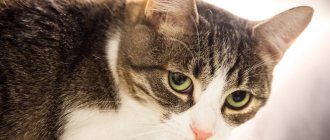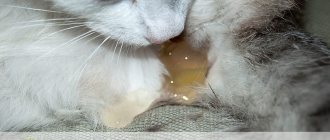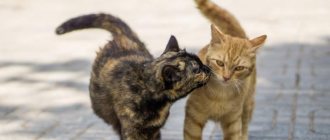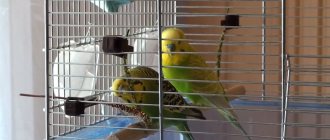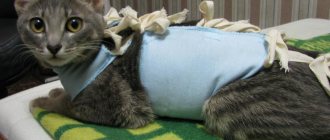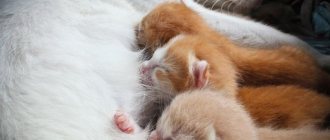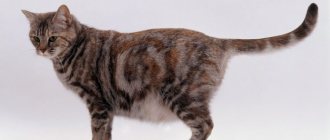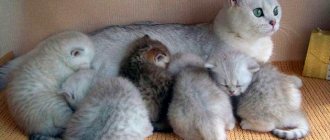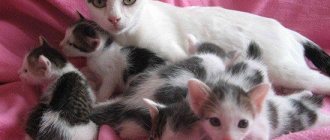Pregnant cat
Cat owners sooner or later face a situation when their pet, having reached physiological maturity, is preparing to have offspring. The only exceptions can be cases when the cat has been sterilized or has completely excluded contact with the opposite sex. Anticipation of the upcoming appearance of kittens is very exciting for owners. Therefore, it is advisable to find out about the upcoming event as soon as possible.
In the article, we talked about how to understand that a cat is pregnant, what signs indicate this, and diagnostic options. You will also learn the peculiarities of the first pregnancy and the peculiarities of caring for a cat.
Why detect a cat's pregnancy in the early stages?
Despite the fact that a cat's body is designed to survive in the wild, care and monitoring of pregnancy are very important. The sooner the owner finds out that she is pregnant, the more time she will have to prepare for the arrival of the babies. For your information! The ability to bear kittens occurs at different ages in each breed. For example, British cats are ready for their first pregnancy only after 1 year of life. It is especially important to monitor the condition of purebred animals (for example, sphinxes, folds). Some breeds may have difficulties during pregnancy and birth. In addition to being monitored by a veterinarian, owners must be able to independently handle the cat during labor if assistance is needed.
I am pregnant?? - Can't be…
Nutritional characteristics of the mother and kittens
A cat that has given birth needs healthy food filled with microelements, vitamins and other beneficial substances.
Cats also drink a lot of water and milk after giving birth. The mother’s body, in turn, needs to secrete its own milk for the kittens, so there should always be plenty of liquid in the mother’s bowl, otherwise the kittens will not have enough milk, and their immunity will begin to weaken. 60 - 70 hours after birth, the appetite increases, the pet begins to drink and eat everything that is offered to it. After a week, the appetite returns to normal, and after a month it even decreases, as the kittens begin to consume some food on their own.
At what stage can pregnancy be determined?
At home, recognizing your pet's pregnancy is a difficult task. So, how do you know if your cat is pregnant?
You can visually recognize a cat’s pregnancy only by the animal’s changed behavior. A month after fertilization, the sides of the abdomen and swollen nipples become noticeable. You can find out about pregnancy in the early stages from your veterinarian. In hospital settings, ultrasound is performed starting from the 20th day after fertilization. At 25 days, an analysis is done at the veterinary clinic, and after 26-30 days, the doctor palpates the abdomen to determine the presence of a fetus. Another way is an x-ray, but it can be done starting from the 40th day.
Ultrasound is an accurate method for determining pregnancy
What can pregnant women eat and drink if they are constipated?
A pregnant woman experiencing constipation needs to carefully monitor her diet. It is important to understand what you can eat if you have problems with bowel movements, and what foods you should avoid. If you have a bowel movement disorder, you should follow some rules:
- Drink at least 1.5–2 liters of clean water daily. You should drink water in small sips. In this case, the liquid should not be too cold. In addition, it is useful to drink herbal teas, natural yoghurts, and kefir. In the third trimester of pregnancy (after 20 weeks), it is necessary to reduce the amount of fluid you drink to 1–1.5 liters per day.
- Cook dishes by steaming or in the oven. Eliminate fatty and fried foods from the menu.
- Make sure that meals are fractional. You need to eat often, in small portions. The interval between meals is no more than 4 hours.
To normalize stool, it is important to form a correct nutritional system. Your daily menu should include fresh vegetables and fruits that are high in fiber. A large amount of healthy dietary fiber is found in apples, sauerkraut, green salad, apricots, artichokes, raspberries, and black currants.
You can eat wheat bran, almonds, hazelnuts, and green peas. Dried fruits, stewed vegetables, as well as buckwheat and oatmeal facilitate bowel movements. It is better to choose coarse bread, it has more benefits for digestion.
Fermented milk products are important. They are rich in beneficial bacteria and help improve microflora and eliminate constipation. It is better to choose kefir, yogurt, and yogurt. So, one of the proven folk remedies for constipation is a glass of yogurt + 20 pieces of dried apricots at night. If you have this problem, it is better to avoid whole milk. It stimulates increased gas formation and can cause increased abdominal pain.
Of the juices, it is better to give preference to apricot, pumpkin, plum, carrot, peach, and you should give up apple and grape for a while.
The list of prohibited products includes:
- chocolate, baked goods;
- cocoa, black tea and coffee;
- rice, pasta;
- radishes, garlic, onions, mushrooms;
- fatty meats, spicy dishes;
- canned food, smoked meats.
The consumption of dairy products with a high percentage of fat should be greatly limited - it is better to eat cream, full-fat sour cream, and ice cream less often. You will also have to temporarily give up hard-boiled eggs. Rusks, rice water, strong black tea, berry jelly, astringent fruits, pomegranates and infusions of pomegranate peels, unripe pears, black grape varieties have a strengthening effect.
For constipation, it is advisable to exclude from the diet foods that cause fermentation and flatulence. It is better to completely remove white and brown sugar, store-bought juices and carbonated drinks from the menu. Legumes and vegetables with a lot of essential oils also stimulate increased gas formation, so limit their consumption or eliminate them from your diet altogether.
A review of the usual diet is the first thing an expectant mother who is experiencing constipation needs to do. In addition, pregnant women should not eat salty dishes and foods, as they retain fluid in the body and can cause swelling.
The diet and fluid intake, as well as the daily diet, must be selected individually. It is best to do this together with the doctor monitoring the pregnancy.
It is important to understand that some dishes and products cause individual reactions in us, and the effect of their consumption largely depends on the characteristics of the gastrointestinal tract. For example, semolina porridge can have a fixing effect in your case and not affect the functioning of the digestive system of another person.
It may be useful to keep a food diary, where you record your observations, which will allow you to identify certain patterns: how certain foods affect your stool. This will help develop the most effective diet, taking into account the needs of the body and personal characteristics.
Get rid of intestinal problems
The natural British drug is not addictive and works immediately
Find Phytomucil with benefits
Accurate signs of pregnancy
After mating, the owner must carefully monitor the condition of the cat, since the appearance of uncharacteristic symptoms may indicate a pathology of pregnancy. In addition, intercourse sometimes does not lead to fertilization, resulting in the need for additional mating.
And here, all the owners are wondering: how can they understand that the cat is pregnant? The most informative signs of pregnancy include an increase in the size of the abdomen, changes in behavior, cessation of estrus and some other manifestations.
Estrus refers to the manifestation of the period of arousal in the sexual cycle. The processes accompanying this stage are aimed at changing both the behavior and the state of the cat’s reproductive tract, which will contribute to attracting a male and fertilization. Accordingly, in the case of successful conception, continuation of estrus is not advisable, so signs of arousal disappear - the vaginal mucosa loses hyperemia, the secretion stops being released from the loop.
The cat goes into heat
If estrus continues after mating, this indicates a failed pregnancy. If the lack of conception is confirmed, the breeder will have to resort to re-mating the female.
We will tell you the signs of pregnancy in a cat.
Changing nipples and belly
The earliest sign of pregnancy in a cat is a rounding of the abdomen due to an increase in the size of the uterus as a result of the growth of the fetus. The sign is usually detected after one month from the date of mating. The rate of growth of the abdomen, as well as its size, depend on the individual characteristics of the female, the number and size of the offspring. During this period, the first movement can be determined by palpation. To do this, carefully palpate the lateral sections of the abdomen.
Changes in nipple pigmentation begin in the first days after conception. The color becomes brighter, they acquire the maximum pink tint in the last stages. The greatest change in color is typical during a cat's first pregnancy. As delivery approaches, the nipples swell, which is a preparation for breastfeeding the offspring. Such changes are caused by the action of hormones.
Nipple enlargement
The first release of milk, or rather colostrum, occurs approximately seven days before the kittens are born. The secreted substance contains a large amount of protein and fat, and subsequently its composition changes somewhat.
Changes in appetite
To answer the question of how to determine if a cat is pregnant, you need to monitor your pet’s behavior. In the first weeks after mating, the animal's appetite rarely decreases. Sometimes vomiting is observed in the morning. Unfortunately, vomiting can be the cause of many diseases, in particular worms. Therefore, if this sign is present, it is advisable not to delay and take the cat to the veterinarian. From the middle of pregnancy, the appetite grows rapidly, so during the process of bearing kittens, a cat can gain up to 3 kg.
The cat has a good appetite
Change in Behavior
A possible pregnancy can be determined by changes in the animal's character and behavior. At first, the cat behaves slightly aggressively. From the second half of gestation of kittens, the cat’s behavior changes in the opposite direction. She looks affectionate and gentle, and tries to spend most of her time with her owner.
At the same time, the animal eagerly makes contact with its owners, asks to be petted and climbs into their arms. There may be an increase in appetite - the animal constantly asks for food, and does this with great persistence. At 5–7 weeks, the kittens begin to move imperceptibly in the mother’s womb.
A couple of days before the kittens appear, the animal shows special care and attentiveness, starting to lick the owners or other inhabitants of the apartment in every possible way, showing concern for them.
Excessive affection appears in later stages
Drowsiness and apathy
The most common symptoms are increasing weakness and lethargy. An active cat becomes calmer, spends most of its time lying down, and loses interest in games. In phlegmatic pets, the signs are less noticeable. This condition is associated with the action of hormones.
The cat sleeps more, plays less
What are the precursors of labor and when do they occur?
Precursors of labor are signs that indicate the body is actively preparing for labor. Female sex hormones play a primary role in this process. And if progesterone “rules” in the female body throughout pregnancy, then before childbirth it gives way to estrogens.
The precursors of labor are a training period before delivery. Most often they occur 10-14 days before the baby is born. However, this figure is individual. It happens that precursors appear a week or even a few days/hours before birth.
Diagnosis of pregnancy
Formally, ovulation occurs 24-30 hours after mating. For convenience, breeders calculate the total cycle length as the difference between the day of birth and the day of mating. On average, gestation of kittens lasts 62-68 days. The longest period is typical for the Siamese-Oriental group. These cats have offspring only 71 days after mating. How to determine if a cat is pregnant?
An earlier and more accurate diagnosis of a cat’s pregnancy can be done in the clinic using imaging studies:
- ultrasonography
- radiographic examination
Ultrasound can reliably diagnose a cat's pregnancy from the 20th day, and this method also allows you to monitor the development of the fetus throughout the pregnancy. The only parameter that is often impossible to determine using this type of study is the number of fetuses, especially in multiple pregnancies. The second method of visual diagnosis is radiography. This study is relevant no earlier than 4-5 weeks, since until this moment the bones of the fetus contain a small amount of minerals and are poorly visualized on an x-ray.
The most accurate method for determining pregnancy
X-ray allows you to confirm a cat’s pregnancy if it is not possible to conduct an ultrasound examination (there is no equipment in the clinics closest to you) and palpation is difficult (for example, the animal is aggressive or very obese). Also, using an x-ray, you can more accurately calculate the number of fetuses.
Pregnancy screening for cats
A veterinarian should check to see if your cat is pregnant. When examining cats, an assistant should hold the animal in a lying position. To do this, take the fold of skin near the back of the head with the right hand, and with the left hand grab both hind limbs in the metatarsal area, place the cat on the table and stretch it slightly so that it cannot squirm and scratch with the forelimbs or bite. The cat is held in a dorsal position and palpated through the abdominal wall with one hand.
For palpation, grasp the abdominal wall between the thumb and other fingers at the level of the lumbar vertebrae and gently squeeze the fingers. The rectum is often palpated here if it is filled with feces. Trying not to weaken the pressure of the fingers, move them down. At the same time, in non-pregnant cats, uterine horns are sometimes found, diverging in the form of elastic cords. In pregnant cats, uterine ampoules or fetuses are found.
Palpation by a veterinarian
Hunger as a symptom of severe stress after childbirth
The most common reason for refusing food after childbirth is severe stress. As practice shows, a cat experiences the greatest anxiety if she cannot feed her kittens. There are four common causes of such disorders: agalactia, disruption of the mammary glands, galactostasis (lactostasis) and mastitis. Let's look at these concepts in more detail.
Agalactia is the most dangerous phenomenon, accompanied by the complete inability of the mother to produce milk. Pathology is divided into two types. The congenital form is extremely rare and is caused by a malfunction of the pituitary gland. In this case, the mother leaves the nest immediately after giving birth, eats, drinks, but completely ignores the offspring.
Important! If agalactia is detected in a purebred cat, it is excluded from breeding, and the entire litter is subject to castration, since the disease can be congenital and it is inherited.
In secondary agalactia, the cat is unable to produce milk due to pain, stress, or after premature birth. In all three cases, the young mother feels unwell, is very worried, does not eat and tries to care for the kittens. Secondary agalactia is reversible if the kittens nurse from their mother. To help your cat come to its senses you need to:
- Provide mother and kittens with complete rest.
- Constantly offer your cat a warm drink.
- Use drugs that enhance lactation.
- If the kittens are weak and cannot suckle, they are fed additionally, and the cat’s nipples are gently massaged.
Important! Secondary agalactia can occur within 2–3 weeks after birth!
Malfunction of the mammary glands or insufficient milk supply leads to increased anxiety in kittens and severe stress in the cat. There are many possible reasons: genetic predisposition, difficult or protracted labor, premature birth, multiple litters, etc.
Features of the first pregnancy
A pet can become pregnant immediately after the onset of the first heat - at 7-8 months. At this age, the body is formed for fertilization, but is not yet ready for safe bearing of offspring. Because of this, mating is carried out only on the third heat.
- The arousal stage corresponds to the period of maximum readiness of the animal for conception. Changes in the genital organs occur under the influence of gonadotropic hormones. In this case, the appearance of estrus is observed, which is characterized by swelling, edema and hyperemia of the vulva, and the release of mucus from the loop. Sexual arousal is accompanied by a change in the pet’s behavior - the cat becomes restless, active, and its appetite decreases. Next, the heat stage is formed, which is characterized by the female’s readiness to mate; at this moment she looks active and restless. Ovulation is the release of a mature follicle. This process in cats has its own peculiarity - the mechanism starts only after sexual intercourse after 1-2 days.
- The period of inhibition indicates a decrease in sexual activity. At this moment, the cat’s estrus ends: the mucous membranes of the genital tract return to their normal state, and the secretion of mucous secretion stops.
- The balancing period is characterized by the restoration of the cat's behavior and lack of attraction to males.
A cat can become pregnant immediately after the first heat, but it is best to breed at the age of 1.5 years
Young animals are bred at approximately 1.5 years. This reduces the risk of miscarriages and the birth of kittens with serious pathologies. If your furry pet becomes pregnant for the first time, then all the symptoms are more pronounced.
The safety of mating decreases after 6 years. At this age, breeding animals are sterilized. If you do not plan to breed the breed, sterilize your pet immediately after reaching maturity. This will reduce the risk of developing cancer to 0.5%.
A cat's first gestation is exciting for the owner. If a person can say what bothers him, then an animal cannot. Therefore, we do not always understand how this period proceeds, especially for the first time. The first and subsequent pregnancies last the same. The duration depends on the breed, emotional state, age, number of fruits. But the period should not be less than 60 days or more than 72 days.
Factors on which the period depends
How long a cat will walk while pregnant depends on many factors: its breed, age, condition, number of kittens, etc.
General information
In the case when the birth has already ended, the owner must make sure that all the kittens have been licked by the mother and have already had time to suck on her milk. More precisely, colostrum. And this moment is vital! The fact is that colostrum contains a huge amount of vitamins, minerals, micro- and macroelements, as well as antibodies. It is due to the latter that newborn kittens have immunity. The animal’s own immune system will not start working soon, and therefore in cases where the kittens have not received colostrum in time, they will constantly get sick.
As soon as the mother of the cubs feeds her offspring, she herself will probably want to eat! One small nuance: many inexperienced breeders believe that their cat does not want to eat... But they do not move bowls of water and food closer to the place where their pet feeds her offspring.
For the first two or three days, the animal instinctively cannot leave its cubs for a long time (however, some cats don’t care), and cannot eat normally. Take pity on your pet, place a bowl of food closer to its “den”.
In addition, many mothers do not want to eat for several hours after giving birth. This is no reason to worry! A cat, especially a first-time cat, is so “squeezed out” by the process of giving birth and caring for newborn kittens that she simply has no time to eat. Leave food and water near the basket with the kittens and their mother, and then wait: if everything is in order, the animal will rest and will definitely have an appetite.
Please also note that a cat that has given birth (and is nursing, respectively) needs three times more nutrients, vitamins and microelements than if compared to a nulliparous animal. A happy mother needs noticeably more water. The cat needs all this so that her body can produce enough nutritious milk for kittens.
But! It is believed that after a normal birth, a cat's appetite should appear in about 24 hours in any case. If your pet does not drink at the same time, this is abnormal, and you definitely need to show it to a veterinarian.
After another three days, the appetite greatly increases, as your pet’s body reaches “Stakhanov’s” heights of milk production. After another week, the appetite stabilizes at approximately the same level, and after another two weeks it begins to fall, as the kittens gradually switch to complementary foods. But in cases where the pet that gave birth does not show any interest in food even after a day, this indicates the presence of pathologies (quite possibly very dangerous). We would recommend taking your animal to a veterinarian immediately.
How to distinguish a false pregnancy from a real one
In some cases, indoor and outdoor cats suffer from false pregnancy. The causes of the pathology can be: sudden stress or emotional stress in the pet; mating with a sick cat; improper functioning of hormonal levels; being near a pregnant cat.
False pregnancy in cats
As a rule, the only way to determine whether an outdoor cat is pregnant is to see a veterinarian. Self-diagnosis is not informative due to the abundance of characteristic external signs.
Using an ultrasound, the cat's uterus is examined. The absence of kittens in the womb indicates the development of pathologies in the pet’s body. Treatment is prescribed depending on the cause and form of the disease. Therapy is often carried out using hormonal agents.
If you do not rush for an examination, you may notice the disappearance of symptoms without a trace after some time. Veterinarians do not recommend ignoring diagnosis in a veterinary clinic, since false pregnancy is not always safe.
What is the danger of false pregnancy?
Frequent false pregnancies have a negative impact on the physical and mental health of the pet, increasing the likelihood of developing oncology, endometritis, mastitis, pyometra and other diseases. If hormonal treatment is ineffective, the animal is sterilized.
It is best to contact a veterinary clinic to determine pregnancy
How long does a cat's pregnancy last?
Pregnancy in these animals lasts approximately 9 weeks. Varies from 55 to 63 days. Labor may begin a week earlier or later. It often happens that offspring are born earlier and still grow up healthy.
Pregnancy lasts different amounts of time for different breeds and types. Short-haired individuals bear offspring for 58–68 days, and long-haired individuals bear offspring for 62–72 days.
Labor begins earlier in the following cases:
- A large number of kittens in the litter (up to 57 days).
- Illness during position.
- Young individuals can give birth even on the fiftieth day (but in this case the offspring may be unhealthy).
- Small cats walk with a belly for no more than 65 days.
- Premature labor can begin when there is a sharp change in temperature.
- Weakly developed embryos die inside the animal, causing birth to occur earlier.
- Due to severe fright.
Childbirth will begin earlier if there are a large number of kittens in the litter.
Causes of delayed birth:
- Small offspring.
- Stressful state before childbirth.
- Large and adult cats stay pregnant longer.
- Frozen pregnancy.
- Hypoxia of kittens.
Larger individuals bear offspring longer
An ultrasound can find out the exact cause of the delay.
Features of caring for a cat in an interesting position
Pregnancy is a test for a cat’s body. Since all vital organs work in an intensive mode, the animal requires special care and attention. Favorable conditions play a big role in the course and outcome of the condition.
Diet and vitamins
In the first days of the appearance of increased appetite, the usual feeding rates are increased by 10%. In addition to the quantity of food, it is important to take care of its quality. To give birth to healthy offspring, your pet will need more vitamins and minerals. They can be obtained from super-premium and holistic-grade dry foods designed specifically for pregnant animals.
To change your eating habits you will need:
- Switch to easily digestible meals or special food. In the first case, the addition of vitamin and mineral supplements is mandatory, and in the second, it is discussed individually. Ask your veterinarian for exact dosages and brands.
- Increase the frequency of feedings. Do not try to feed an increased amount of food in 2 meals. Have 5-6 feedings per day. With the beginning of the second trimester, the amount of food should be increased by 2 times compared to the original.
- Change the water regularly. Do not forget to monitor the cleanliness and amount of liquid. Its deficiency or contamination with bacteria can lead to miscarriages.
Do not try to buy vitamins on the advice of friends and acquaintances. This is fraught with hypo- or vitamin deficiency.
During pregnancy, your cat should have a balanced diet.
Main reason for not eating
There are several reasons why an animal may refuse food and even water. Most often, the problem appears due to indigestion - instinctively, after giving birth, the pet eats the afterbirth, trying to restore the balance of nutrients. Refusal to eat is accompanied by intense diarrhea or bouts of vomiting. Alarming symptoms usually go away within 2-3 days.
Owners are advised not to switch the animal to its usual diet - after birth, a special diet will be needed. Be sure to ensure that your pet does not develop intoxication - give more liquid food, warm water, low-fat fermented milk products.
To alleviate the condition and prevent serious problems, veterinarians recommend giving adsorbents and coating drugs. At the same time as preventing intoxication, medications will reduce the risk of irritation of the mucous membranes and reduce the intensity of diarrhea.
Laxatives
All medications that a doctor prescribes for a pregnant woman have certain instructions in the instructions. Medicines undergo a series of tests, based on which researchers conclude whether they penetrate the fetoplacental barrier and what effect they have on fetal development and maternal health.
The FDA, or Food and Drug Administration, has several safety categories for drugs during pregnancy:
- A: long-term studies of the drug’s effect on the body of pregnant women have revealed no risk to the fetus in the 1st trimester; there is no evidence of risk in later stages.
- B: no established risk to the fetus in the 1st trimester, no evidence of risk later.
- C: The benefits of the drug may outweigh the risks/there are no clinical studies in humans.
- D: There is evidence of risk to the fetus, but the potential benefit outweighs the possible risk.
- X: studies have identified fetal abnormalities/adverse reactions that pose a risk that outweighs the potential benefit.
However, the instructions for not every laxative drug contain instructions for permission or prohibition of use in pregnant women. For example, researcher Sokolova (Sokolova M. Yu., 2013, p. 29).
It is known that the list of laxatives approved for use in pregnant women is quite small. Irritating laxatives often lead to prolonged diarrhea and electrolyte disturbances, and also have a mutagenic effect.
Increased intestinal motility from stimulant drugs also stimulates uterine contractions. Their long-term use provokes degenerative changes in the intestinal nervous system. These drugs are genotoxic and mutagenic.
Osmotic laxatives may be recommended for constipation during pregnancy. But it is important to take into account the peculiarities of using such drugs: they require drinking a large amount of liquid. This can cause a shift in water balance and the development of edema. If you do not consume more than 1.5 liters of fluid per day, there is a possibility of developing disorders.
That is why a laxative must meet three important conditions:
- safety for the fetus;
- safety for women's health;
- safety for the course of pregnancy itself.
There is a category of women who enter pregnancy with a history of constipation. Among them there are also those who already use certain medications to solve their problem. During pregnancy, it is important to adjust the approach to getting rid of defecation retention. You should tell your doctor what medications you have been taking and for how long. Self-medication in this case is unacceptable, since it is often necessary to abandon habitual laxatives in order to avoid complications.

